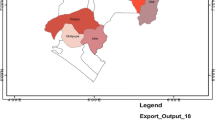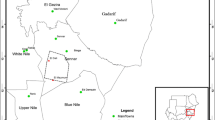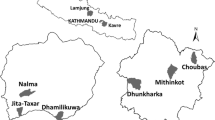Abstract
This study, using cross sectional data from 170 farmers, empirically established that agroforestry positively affects food security and significantly reduces income variability among farmers in Bundelkhand region lying in semi-arid tropics of central India. A 1% increase in the tree density and tree diversity on farm significantly increases food security status by 0.231% and 0.141% points, respectively. Further variability in income reduces by around 0.38% and 0.16% with unit percentage increase in tree density and diversity, respectively. Therefore, amid the epoch of global climate change, agroforestry practice can be a crucial climate smart agriculture option. Farmers’ challenges were also identified and ranked by using Problem Confrontation Index (PCI). The study unveils that, efforts towards controlling stray animals, creating marketing environment, strengthening and streamlining the extension services for more technological and input support requires a strategic institutional framework as a key to upgrade agroforestry in the region.



Similar content being viewed by others
References
Birthal PS, Negi DS, Kumar S, Aggarwal S, Suresh A, Khan T (2014) How sensitive is Indian agriculture to climate change? Ind J Agri Econ 69(4):474–487
CAFRI (2013) Annual Report 2013. ICAR-Central Agroforestry Research Institute, Jhansi, India.
Chavan S, Newaj R, Keerthika A, Ram A, Jha A, Kumar A (2014) Agroforestry for adaptation and mitigation of climate change. Popular Kheti 2(3):214–220
Chavan SB, Keerthika A, Dhyani SK, Handa AK, Newaj R, Rajarajan K (2015) National agroforestry policy in India: a low hanging fruit. Curr Sci 108(10):1826–1834
Choudhary BB, Sirohi S (2020) Modelling climate sensitivity of agriculture in trans and upper gangetic plains of India. Theoret Appl Climato 142(1/2):381–391. https://doi.org/10.1007/s00704-020-03297-y
Choudhary BB, Sirohi S (2022) Understanding vulnerability of agricultural production system to climatic stressors in North Indian Plains: a meso-analysis. Environ Dev Sustain. https://doi.org/10.1007/s10668-021-01997-7
Cornwall A, Jewkes R (1995) What is participatory research? Social Sci Medi 41(12):1667–1676. https://doi.org/10.1016/0277-9536(95)00127-S
Dev I, Ram A, Bhaskar S, Chaturvedi OP (2019) Role of Agroforestry in Current Scenario. In: Dev et al. (eds) Agroforestry for Climate Resilience and Rural Livelihood, Scientific Publishers, Jodhpur, India, pp 1–10.
Dhyani SK, Handa AK (2013) India needs agroforestry policy urgently: issues and challenges. Ind J Agroforestry 15(2):1–9
Dhyani SK, Handa AK (2013) Agroforestry in India and its potential for ecosystem services. In: Dagar JC et al (eds) Agroforestry systems in India: livelihood security and ecosystem services. Advances in Agroforestry, Springer, India, pp 345–366
Dinesh D, Campbell BM, Bonilla-findji O, Richards M (2017) 10 Best bet innovations for adaptation in agriculture: a supplement to the UNFCCC NAP Technical Guidelines. CCAFS Working Paper no. 215. Wageningen, The Netherlands: CGIAR Research Program on Climate Change, Agriculture and Food Security (CCAFS)
Douyon A, Worou ON, Diama A, Badolo F, Denou RK, Touré S, Sidibé A, Nebie B, Tabo R (2022) Impact of crop diversification on household food and nutrition security in southern and central Mali. Front Sustain Food Syst 5:751349. https://doi.org/10.3389/fsufs.2021.751349
Falco SD, Chavas JP (2009) On crop biodiversity, risk exposure, and food security in the highlands of Ethiopia. Am J Agric Econ 91(3):599–611. https://doi.org/10.1111/j.1467-8276.2009.01265.x
GoI (2001) Report of the Task Force on greening India for livelihood security and sustainable development. Planning Commission, GoI, pp. 254.
IFPRI (2022) 2022 Global food policy report: Climate change and food systems. Washington, DC: International Food Policy Research Institute (IFPRI), pp 146–161. https://doi.org/10.2499/9780896294257
Kidd PS, Parshall MB (2000) Getting the focus and the group: enhancing analytical rigour in focus group research. Qual Health Res 10(3):293–308. https://doi.org/10.1177/104973200129118453
Kraaijvanger R, Sonneveld M, Almekinders C, Veldkamp T (2015) Comparison of methods to identify crop productivity constraints in developing countries. A review. Agron Sust Dev 35(2):625–637. https://doi.org/10.1007/s13593-014-0254-1
Kumar KSK (2011) Climate sensitivity of Indian agriculture: do spatial effects matter? Cambridge J of Reg, Econ Soci 4:221–235. https://doi.org/10.1093/cjres/rsr004
Kumar S, Sharma P, Satyapriya GP, Singh M, Kumar S, Halli HM, Choudhary BB, Bagavathiannan M (2022) Economic impression of on-farm research for sustainable crop production, milk yield, and livelihood options in semi-arid regions of central India. Agro J 114(3):1769–1781. https://doi.org/10.1002/agj2.21062
Mango N, Makate C, Mapemba L, Mapembamm L, Sopo M (2018) The role of crop diversification in improving household food security in central Malawi. Agric Food Secur 7:7. https://doi.org/10.1186/s40066-018-0160-x
Miller DC, Muñoz-Mora JC, Rasmussen LV, Zezza A (2020) Do trees on farms improve household well-being? evidence from national panel data in Uganda. Front Glob Change 3:101. https://doi.org/10.3389/ffgc.2020.00101
National Agroforestry Policy (2014) Department of Agriculture and Cooperation, Ministry of Agriculture, Government of India, pp. 1–13.
Ogle SM, Olander L, Wollenberg L, Rosenstock T, Tubiello F, Paustian K, Buendia L, Nihart A, Smith P (2014) Reducing greenhouse gas emissions and adapting agricultural management for climate change in developing countries: providing the basis for action. Global Change Bio 20:1–6. https://doi.org/10.1111/gcb.12361
Quandt A (2021) Agroforestry trees for improved food security on farms impacted by wildlife crop raiding in Kenya. Trees Forest People 4:100069. https://doi.org/10.1016/j.tfp.2021.100069
Ranjan R (2021) Payments for ecosystems services-based agroforestry and groundwater nitrate remediation: the case of Poplar deltoides in Uttar Pradesh, India. J of Cleaner Prod 287:1250–1259. https://doi.org/10.1016/j.jclepro.2020.125059
Rathod P, Dixit S (2020) Dairying in Bundelkhand region of Uttar Pradesh: constraints to realizing the potential. Ind J Anim Sci 90(1):3–11
Reppin S, Kuyah S, Neergaard AD, Oelofse M, Rosenstock TS (2020) Contribution of agroforestry to climate change mitigation and livelihoods in western Kenya. Agroforest Syst 94:203–220. https://doi.org/10.1007/s10457-019-00383-7
Sapkota TB, Vetter SH, Jat ML, Sirohi S, Shirsath PB, Singh R, Jat HS, Smith P, Hillier J, Stirling CM (2019) Cost-effective opportunities for climate change mitigation in Indian agriculture. Sci of the Total Env 655:1342–1354. https://doi.org/10.1016/j.scitotenv.2018.11.225
Singh P, Goyal M, Choudhary BB, Guleria A (2021) Sustainable food security index: planning tool for district-level agricultural development in Uttar Pradesh. Agril Econ Res Rev 34(1):51–67. https://doi.org/10.5958/0974-0279.2021.00004.5
Singh P, Goyal M, Choudhary BB (2022) How sustainable is food system in India? mapping evidence from the state of Punjab. Environ Dev Sustain. https://doi.org/10.1007/s10668-021-02034-3
WFP (2009) Emergency food security assessment handbook (EFSA), 2nd edn. World Food Programme, Rome, Italy.
Author information
Authors and Affiliations
Corresponding authors
Ethics declarations
Conflict of interest
The authors of the submitted manuscript declare that they have neither financial nor non-financial conflicts of interest relevant for the content of the article.
Additional information
Publisher's Note
Springer Nature remains neutral with regard to jurisdictional claims in published maps and institutional affiliations.
Appendix 1
Rights and permissions
Springer Nature or its licensor (e.g. a society or other partner) holds exclusive rights to this article under a publishing agreement with the author(s) or other rightsholder(s); author self-archiving of the accepted manuscript version of this article is solely governed by the terms of such publishing agreement and applicable law.
About this article
Cite this article
Singh, P., Choudhary, B.B., Dwivedi, R.P. et al. Agroforestry improves food security and reduces income variability in semi-arid tropics of central India. Agroforest Syst 97, 509–518 (2023). https://doi.org/10.1007/s10457-023-00806-6
Received:
Accepted:
Published:
Issue Date:
DOI: https://doi.org/10.1007/s10457-023-00806-6




